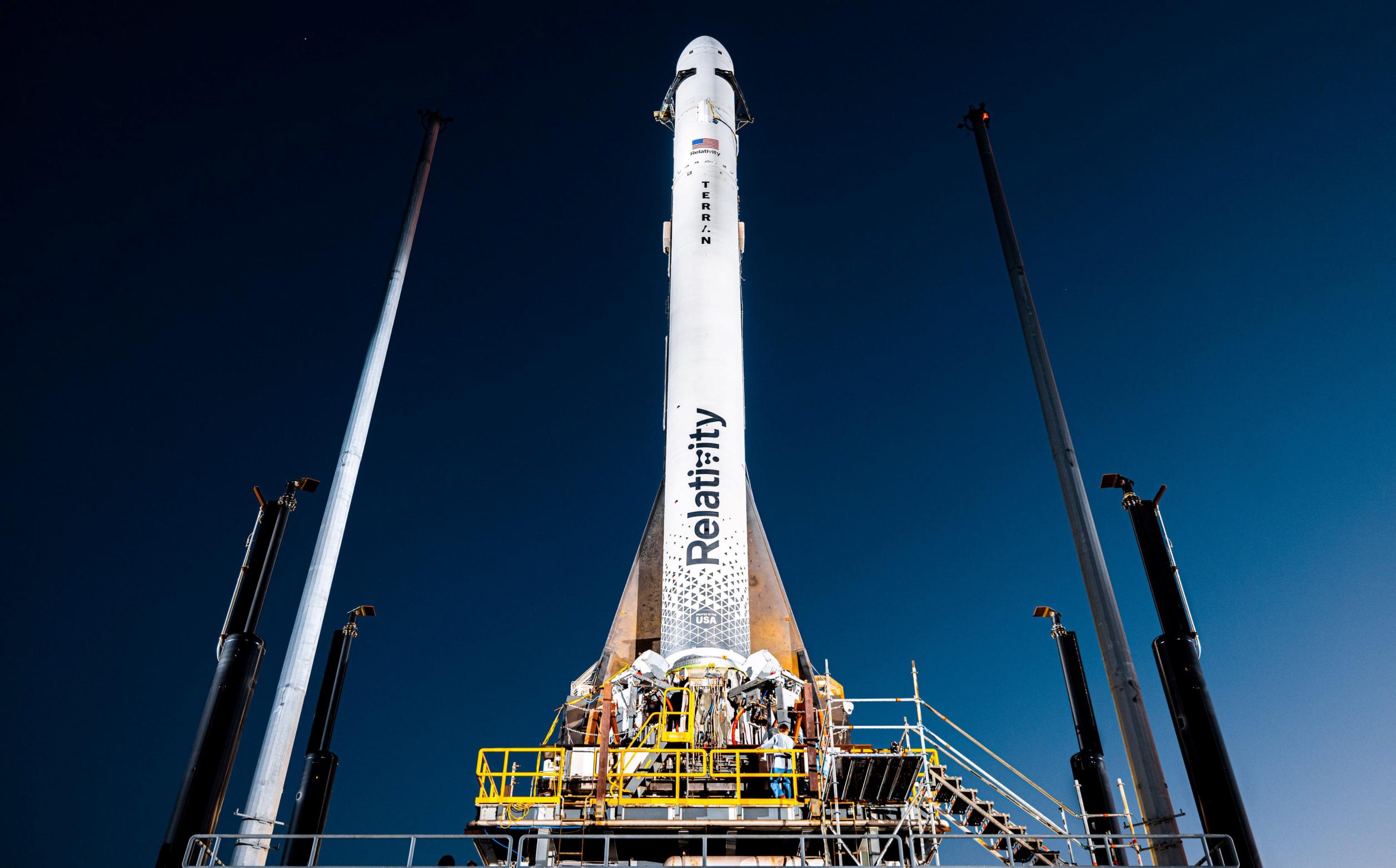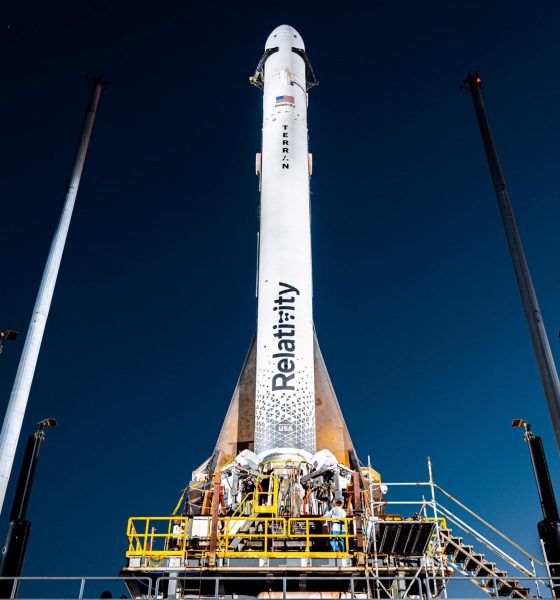

News
Relativity Space’s first 3D-printed rocket goes vertical for launch debut
Relativity Space’s first 3D-printed Terran 1 rocket has rolled out to the startup’s Florida pad and been raised vertical ahead of its launch debut.
Founded in 2015, the private Los Angeles-based spaceflight company shipped its first complete rocket prototype to Florida in June 2022. Prior to that major milestone, Relativity qualified Terran 1’s orbital second stage at leased facilities located at NASA’s Stennis Space Center in southwest Mississippi, and – alongside a nosecone and interstage – arrived at Cape Canaveral Space Force Station (CCSFS) more or less ready to fly.
The last six months have been almost exclusively dedicated to testing Terran 1’s larger and more powerful first stage (booster) as thoroughly as possible. Instead of building a dedicated booster test stand in Mississippi, Relativity chose to modify Terran 1’s lone LC-16 launch pad for the crucial task. Ultimately, the startup was able to complete a large amount of booster testing on the ground, significantly increasing the odds that Terran 1 will perform as expected when it lifts off for the first time.
The update that's rolling out to the fleet makes full use of the front and rear steering travel to minimize turning circle. In this case a reduction of 1.6 feet just over the air— Wes (@wmorrill3) April 16, 2024
Beginning with cryogenic proofing, propellant loading, ‘spin starts,’ and several shorter static fire tests, Relativity’s first Terran 1 booster test campaign culminated with two long-duration static fires in September 2022. The final 57 and 82-second static fires weren’t quite the “full mission duration” tests Relativity had hoped for, but the company concluded that the data gathered was enough to clear the booster for flight.
According to Ellis, one of the most important insights gained from those tests was into Terran 1’s uncharacteristically complex autogenous pressurization system – unprecedented for such a small rocket. Generally speaking, orbital-class rockets store helium gas in small ultra-high-pressure tanks (COPVs) and use helium to pressurize their propellant tanks as they are drained of propellant. Autogenous pressurization refers to an alternative in which a portion of a rocket’s liquid oxidizer and fuel are turned into hot gas and injected back into their respective tanks to pressurize them.
Helium is extremely expensive and an unrenewable resource. In theory, autogenous pressurization – at the cost of being significantly more complex and finicky – can also reduce the amount of dry mass reserved for tank pressurization. While Terran 1 wasn’t able to complete a full-duration static fire, the tests it did complete showed Relativity that its autogenous pressurization systems are unlikely to be a problem in flight, mostly eliminating a major source of uncertainty.
Following the final 82 or 88-second static fire, Relativity returned Terran 1’s booster to LC-16’s hangar and shifted its focus to fully assembling the two-stage rocket and finishing the launch pad. In early December, the company announced that it had fully assembled the first Terran 1. Days later, the rocket was installed on the pad’s “Transporter Erector.” The T/E responsible for transporting the rocket and raising it vertical, but it also needs to connect the rocket to ground systems (propellant, power, comms, etc.) and hold it down before liftoff.
On or around December 6th, Terran 1 rolled out to the pad and was raised vertical soon after. According to Ellis, all that stands between Terran 1 and its first launch is a short integrated static fire test and a launch license from the Federal Aviation Administration (FAA). It’s impossible to say how long the FAA will take, but it’s likely that Relativity will be technically ready to launch just a handful of weeks from now.
Beyond building a relativity impressive rocket, Relativity’s claim to fame is large-scale 3D printing. The startup says that the first Terran 1 rocket – booster, upper stage, fairing, engines, and all – is 85% 3D-printed by mass and the largest single 3D-printed object ever built. Terran 1 reportedly weighs around 9.3 tons (20,500 lb) empty; will measure around 33 meters (110 ft) tall and 2.3 meters (7.5 ft) wide; and will produce around 90 tons (~200,000 lbf) of thrust at liftoff. The rocket is designed to launch 1.25 tons (~2750 lb) to low Earth orbit for $12 million

News
Tesla FSD fleet is nearing 7 billion total miles, including 2.5 billion city miles
As can be seen on Tesla’s official FSD webpage, vehicles equipped with the system have now navigated over 6.99 billion miles.

Tesla’s Full Self-Driving (Supervised) fleet is closing in on almost 7 billion total miles driven, as per data posted by the company on its official FSD webpage.
These figures hint at the massive scale of data fueling Tesla’s rapid FSD improvements, which have been quite notable as of late.
FSD mileage milestones
As can be seen on Tesla’s official FSD webpage, vehicles equipped with the system have now navigated over 6.99 billion miles. Tesla owner and avid FSD tester Whole Mars Catalog also shared a screenshot indicating that from the nearly 7 billion miles traveled by the FSD fleet, more than 2.5 billion miles were driven inside cities.
City miles are particularly valuable for complex urban scenarios like unprotected turns, pedestrian interactions, and traffic lights. This is also the difference-maker for FSD, as only complex solutions, such as Waymo’s self-driving taxis, operate similarly on inner-city streets. And even then, incidents such as the San Francisco blackouts have proven challenging for sensor-rich vehicles like Waymos.
Tesla’s data edge
Tesla has a number of advantages in the autonomous vehicle sector, one of which is the size of its fleet and the number of vehicles training FSD on real-world roads. Tesla’s nearly 7 billion FSD miles then allow the company to roll out updates that make its vehicles behave like they are being driven by experienced drivers, even if they are operating on their own.
So notable are Tesla’s improvements to FSD that NVIDIA Director of Robotics Jim Fan, after experiencing FSD v14, noted that the system is the first AI that passes what he described as a “Physical Turing Test.”
“Despite knowing exactly how robot learning works, I still find it magical watching the steering wheel turn by itself. First it feels surreal, next it becomes routine. Then, like the smartphone, taking it away actively hurts. This is how humanity gets rewired and glued to god-like technologies,” Fan wrote in a post on X.
News
Tesla starts showing how FSD will change lives in Europe
Local officials tested the system on narrow country roads and were impressed by FSD’s smooth, human-like driving, with some calling the service a game-changer for everyday life in areas that are far from urban centers.

Tesla has launched Europe’s first public shuttle service using Full Self-Driving (Supervised) in the rural Eifelkreis Bitburg-Prüm region of Germany, demonstrating how the technology can restore independence and mobility for people who struggle with limited transport options.
Local officials tested the system on narrow country roads and were impressed by FSD’s smooth, human-like driving, with some calling the service a game-changer for everyday life in areas that are far from urban centers.
Officials see real impact on rural residents
Arzfeld Mayor Johannes Kuhl and District Administrator Andreas Kruppert personally tested the Tesla shuttle service. This allowed them to see just how well FSD navigated winding lanes and rural roads confidently. Kruppert said, “Autonomous driving sounds like science fiction to many, but we simply see here that it works totally well in rural regions too.” Kuhl, for his part, also noted that FSD “feels like a very experienced driver.”
The pilot complements the area’s “Citizen Bus” program, which provides on-demand rides for elderly residents who can no longer drive themselves. Tesla Europe shared a video of a demonstration of the service, highlighting how FSD gives people their freedom back, even in places where public transport is not as prevalent.
What the Ministry for Economic Affairs and Transport says
Rhineland-Palatinate’s Minister Daniela Schmitt supported the project, praising the collaboration that made this “first of its kind in Europe” possible. As per the ministry, the rural rollout for the service shows FSD’s potential beyond major cities, and it delivers tangible benefits like grocery runs, doctor visits, and social connections for isolated residents.
“Reliable and flexible mobility is especially vital in rural areas. With the launch of a shuttle service using self-driving vehicles (FSD supervised) by Tesla in the Eifelkreis Bitburg-Prüm, an innovative pilot project is now getting underway that complements local community bus services. It is the first project of its kind in Europe.
“The result is a real gain for rural mobility: greater accessibility, more flexibility and tangible benefits for everyday life. A strong signal for innovation, cooperation and future-oriented mobility beyond urban centers,” the ministry wrote in a LinkedIn post.
News
Tesla China quietly posts Robotaxi-related job listing
Tesla China is currently seeking a Low Voltage Electrical Engineer to work on circuit board design for the company’s autonomous vehicles.

Tesla has posted a new job listing in Shanghai explicitly tied to its Robotaxi program, fueling speculation that the company is preparing to launch its dedicated autonomous ride-hailing service in China.
As noted in the listing, Tesla China is currently seeking a Low Voltage Electrical Engineer to work on circuit board design for the company’s autonomous vehicles.
Robotaxi-specific role
The listing, which was shared on social media platform X by industry watcher @tslaming, suggested that Tesla China is looking to fill the role urgently. The job listing itself specifically mentions that the person hired for the role will be working on the Low Voltage Hardware team, which would design the circuit boards that would serve as the nervous system of the Robotaxi.
Key tasks for the role, as indicated in the job listing, include collaboration with PCB layout, firmware, mechanical, program management, and validation teams, among other responsibilities. The role is based in Shanghai.
China Robotaxi launch
China represents a massive potential market for robotaxis, with its dense urban centers and supportive policies in select cities. Tesla has limited permission to roll out FSD in the country, though despite this, its vehicles have been hailed as among the best in the market when it comes to autonomous features. So far, at least, it appears that China supports Tesla’s FSD and Robotaxi rollout.
This was hinted at in November, when Tesla brought the Cybercab to the 8th China International Import Expo (CIIE) in Shanghai, marking the first time that the autonomous two-seater was brought to the Asia-Pacific region. The vehicle, despite not having a release date in China, received a significant amount of interest among the event’s attendees.








